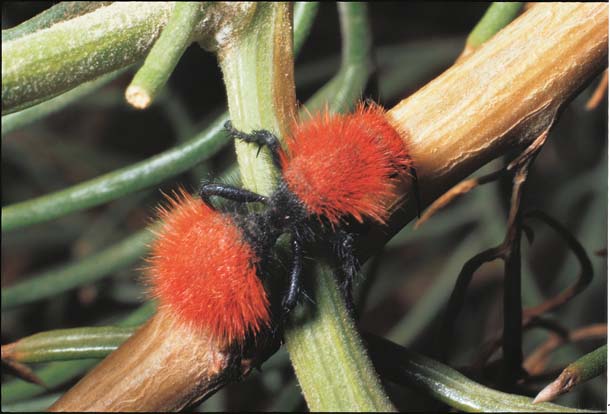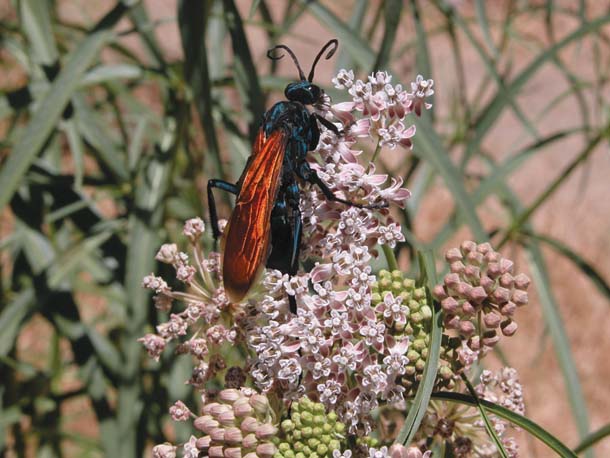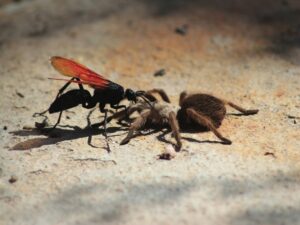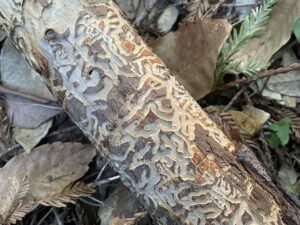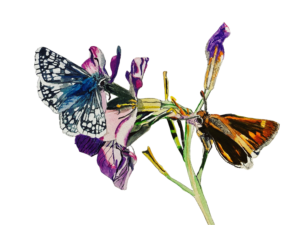You always remember your first sting. Mine was at summer camp, near the bathhouse. A careless step put a bumblebee between my bare foot and the flower she was visiting. Usually slow to anger, this worker bee reacted poorly to the pressure of my foot on her exoskeleton. Yikes!
Bees, ants, and wasps have stingers that have evolved from the females’ egg-laying organ (ovipositor), so only females can sting. (The line from “I’m bringing home a baby bumblebee”—”Ouch! He stung me!”—is wrong: “He” doesn’t sting.) Most stings happen when people or pets get near the insects’ colony. The insects respond by stinging intruders in defense of their young or stored food.
Bee and wasp venoms have been fine-tuned over millions of years (and hundreds of millions of stings) to affect vertebrates in particular ways: Most venoms are painful but not toxic, unless you’re allergic. Entomologists say, “You aren’t dying, but you’ll feel like you are” when talking about the strongest stinging insects we have around here, the velvet ant (actually a wingless wasp) and the tarantula hawk, a wasp whose sting is strong enough to paralyze tarantulas, which it hunts as food for its offspring. For vertebrates like you and me, long-lasting pain teaches a lesson hard to forget; the next time you encounter a red-and-black, yellow-and-black, or orange-and-black insect, you’ll back away. Once stung, twice shy.
Justin Schmidt, a bee researcher for the USDA, has been stung by many kinds of insects in the course of his work. He has also interviewed other entomologists about their stinging experiences. He created a scale (which others have dubbed the Schmidt Pain Index) that assigns values of 0 to 4 to the pain produced by a stinging insect. Zero means the insect cannot penetrate skin (so no pain), and 4 means you can’t do anything else but scream (Schmidt writes, “causing immediate, excruciating, totally debilitating pain that completely eliminates the ability of the stung individual to continue to act in a normal fashion”). The stings of the common honeybee and the yellow jacket wasp are both 2, the velvet ant a 3, and the tarantula hawk a 4.
You can avoid being stung this summer in several ways. Be sure to keep a lid on your soft drinks, and check that no wasp has gone in before you sip. Some sodas are particularly attractive to yellow jackets. Don’t wear yellow or shiny purple clothes; these are particularly attractive to yellow jackets. If the wasps do arrive at your picnic, don’t swat at them—that just increases your chance of being stung.
Yellow jackets and bumblebees have smooth stingers that don’t get stuck in you, so they can sting repeatedly. Honeybees have barbed stingers that tear out when they sting, so the bee dies in defense of its “comb, sweet comb.” If you’re stung by a honeybee, remove the stinger as quickly as possible: The attached venom sac and muscles can continue to pump venom after the bee has died.
Get out
Now that you know about our local stinging insects, get outside and see them for yourself. As long as you treat them with a little respect, you’re not likely to get stung.
Start at the San Francisco Zoo’s Insect Zoo and check out the bee exhibit. This working beehive, visible as a cross-section behind transparent plastic, started with a scrap of honeycomb, a transplanted queen, and a few workers. The colony and its hive have since grown to fill the exhibit. See if you can spot the queen (tagged for easy identification), and track the workers as they leave the hive to forage in the nearby bushes. While you’re at the zoo, take a look at the displays of stinging and nonstinging bugs—ants, scorpions, cockroaches, and millipedes—from all over the world.
Or bring the bees to you by making your yard more attractive to them. You don’t have to remodel the entire yard: even a few patches of the right plants can make a haven for bees, important pollinators for many native plants and food crops. To attract native bees, which generally don’t sting, stick with plants adapted to our climate. Make sure you plant a variety: Small clusters of several types of flowers will attract more bees than a large patch of one type, and an assortment of flowers that bloom at different times will give the bees food year-round. Many solitary native bees nest in shrubs or in the ground, so don’t use fertilizers and pesticides, and don’t mow frequently, since that can damage their nests. Start with California poppies, gumplant, clarkia, or coyote mint, and then see what works best in your garden.
[David Carroll]

